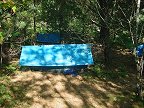| From Strugglingteens.com Visit Reports Saranac Lake, New York
This 28-day wilderness program combines both expedition and base-camp formats. As we walked into their campsite, the students looked like they were taking a temporary layover from a very long expedition. Grubby faces and clothing were the rule, with some smiling and others less than happy about the experience. A tarp was hung up on the side of a clearing as a temporary lean-to, sleeping bags were spread out, and a small cook fire was smoking in the center of the clearing. Even though we were only a few hundred feet from where we parked the car, for all we could tell at the campsite, we could have been in the middle of a vast wilderness with no other humans for hundreds of miles. The sense of isolation from civilization was virtually complete, and the program’s building on the pioneer heritage as a model seemed to be working.
“Mask-of-black” is the program’s substitute for the solo or vision quest that is common in other wilderness programs. It is called this because the student will blacken his or her face, as a reminder to the rest of the group that the student has become invisible, like a spirit figure often mentioned in Indian mythology. The impact is that the student thus severs ties with others, and emotionally and spiritually becomes isolated from the group. The developers of this experience had determined that the emotional impact of this is similar to the solo experience used by other wilderness programs, but safer because the student is under constant observation. While in “mask-of-black,” the student maintains his/her daily routine in the campsite, but with no interaction with the other students, as if they were just a spirit. One immediate powerful lesson the student will learn is how much of life is tied up in simple interactions with others, and consequently how important relationships are to the quality of life. As the experience goes on, and the student is forced to confront what is happening both internally and externally, these lessons are driven home in a multitude of ways. The one student in the group, who had already gone through the “mask-of-black” experience, credited it with being perhaps the highlight of the program, and what had caused him to learn the most about who he was and what was important in his life. Of course, most of what goes on in the program is not visible to the casual visitor, and what is going on behind the campsite view has to be explained. Each step of the program is built on those preceding it, gradually expanding the scope of the student’s perspective. The whole curriculum is designed for character development, starting with attitudes that students have about themselves and expanding to include a perspective about what would help them grow in positive ways. The program emphasizes teaching students how to take care of themselves and how to develop positive group interactions, and even includes mental and physical relaxation exercises.
Each student starts the program with two staff members giving him/her their complete attention, which lasts for a day or two. Completing that assessment period, the student joins the group in what they call the turtle phase. This is a base camp model that helps the students learn basic strategies for: personal hygiene, group safety, dealing with insect bites and poison ivy, journal writing for self-discovery and proper care of the environment. The turtle phase is used as a metaphor for the student’s attitude and usually lasts about 4-5 days. Once students have completed the requirements contained in the program lesson and growth books, they petition for and if found ready, move to the Bear phase. This phase primarily focuses on self-care, which includes looking at what they have been doing to themselves and how they might take better care of themselves, both physically and emotionally. They learn about active listening and how to develop basic leadership qualities. The “mask-of-black” experience is part of this, since “mask-of-black” seems to be a powerful tool to help the student take a good look at who they really are. Coming out of “mask-of-black,” the student is helped by staff and the other students to process the experience. When they think they are ready, each student petitions for the Wolf phase, which focuses on how to become a part of a team. Communication and interpersonal skills are key items here, again using the wolf as a metaphor. There is one more phase that only some of the students achieve: the Hawk phase, which involves more work on genuine relationships, effective leadership, and learning the importance of being alert to their surroundings. Students who achieve the Hawk phase are looked up to as leaders because they have earned it. In this way they learn even more about the responsibilities that go along with constructive leadership. The staff had explained that an important focus of the program was what they call “pattern exhaustion.” That is, as their old patterns manifested, the student would be reminded that they were in an old pattern of theirs. This was usually pointed out by the other students since the program has a very heavy emphasis on peer culture. In our original group discussion, when we first arrived, all the students had brought up how important it was for them to have been isolated from their past patterns. All the students in the program receive an impact letter from home, in which their parents outline why they had enrolled them, their fears for their future, and how the students’ behaviors have affected their parents. This letter is shared with the group, since nothing can destroy a group’s cohesiveness more quickly than secrets, especially secrets about what led to the enrollment. Letters home are exchanged weekly throughout the time the students are in the program. Although this is a new program, Adirondack Leadership Expeditions is built and managed by staff who have had many years of experience working with emotional growth and therapeutic schools and programs. From the way the students were talking, the therapeutic processes used by Adirondack appear to be effectively creating what I expect would be a successful wilderness experience for students who need help. © Copyright 2012 by Woodbury Reports, Inc. |


